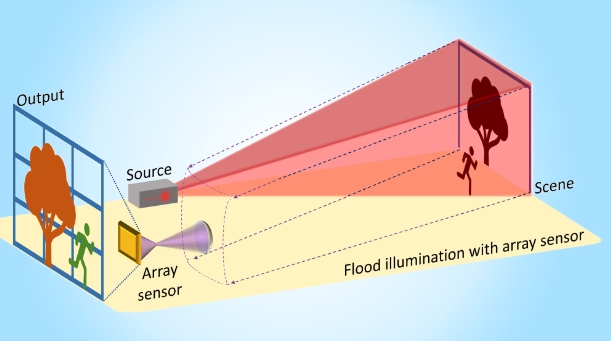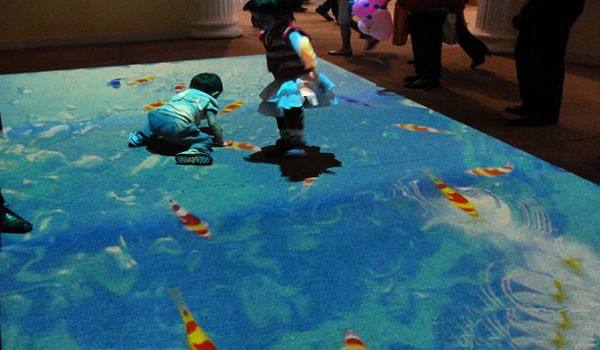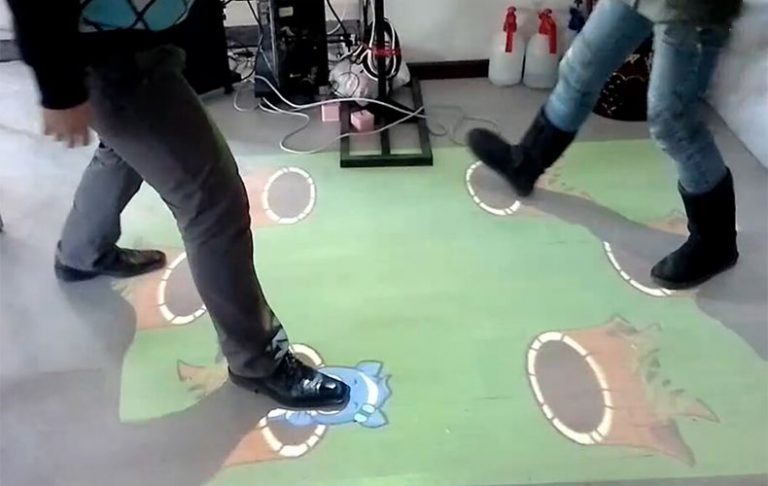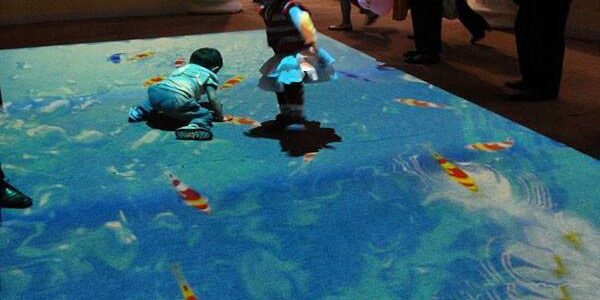Introduction
Floor interactive projection systems are transforming public spaces into dynamic, interactive zones. From exhibition halls to shopping centers, this technology enables users to engage with virtual scenes projected onto the floor simply by stepping into the projection area. Using hands, feet, or movement, participants can interact with digital elements, making exhibitions more engaging and vibrant. But how exactly does floor interactive projection achieve such seamless human-computer interaction? This article explores the core technologies and components behind floor interactive projection systems.
1. The Basics of Floor Interactive Projection

Floor interactive projection is a projection technology that displays images on the ground. Unlike traditional displays, it doesn’t require a screen or physical touchpoints; instead, users interact directly with virtual scenes through their body movements. Whether it’s stepping on an image to make it ripple like water or kicking a virtual soccer ball, floor interactive projection creates unique, immersive experiences that enhance audience engagement. This interaction is achieved through a combination of projection and sensor technology that continuously tracks the movements of users in real-time.
2. How Floor Interactive Projection Systems Work
At the heart of any floor interactive projection system is a combination of hardware and software that coordinates to detect, track, and respond to human motion:
- Projection Equipment: A projector, typically mounted overhead, displays dynamic images onto the floor. This projector often includes infrared filtering to make it compatible with sensors that detect and track movements.
- Sensing and Tracking Devices: Sensors and cameras, including infrared cameras, monitor the projection area. These devices detect changes in the environment, such as people entering or moving within the projection area.
- Interactive Software: Special software analyzes movement data from the sensors and modifies the projected content based on user actions. For instance, if someone steps on a virtual pond, the software creates ripples and moves fish around the foot’s location, simulating a realistic interaction.
3. Key Technologies Behind the Interaction
Several advanced technologies come together to enable this interactive experience:
- Motion Capture Technology: Sensors capture the user’s motion by detecting changes between frames. This allows the software to recognize where a person has moved and create a corresponding interactive response on the projection.
- Infrared Technology: Infrared light illuminates the interaction zone, and infrared cameras capture the scene. The software then separates users from the background, recognizing them as interactive elements.
- Image Differencing: By comparing consecutive frames, the software identifies movement and extracts relevant portions where action is happening. This difference allows for smooth, real-time interaction between the user and the projection.
- LiDAR Integration (Optional): Advanced systems like those provided by CPJ ROBOT use LiDAR technology and specialized software to detect and interpret more complex gestures and movements, making the interactions even more precise and immersive.
4. Popular Floor Interactive Projection Applications
Floor interactive projection is popular for various applications, each providing a different kind of experience. Here are some of the most common uses:
- Interactive Sports Games: Virtual soccer games let players kick a digital ball across the floor. Sensors track each kick, creating a realistic gameplay experience that’s fun for children and adults alike.

- Virtual Water Ponds: When users step into a projection of a pond, ripples and waves appear, and virtual fish swim away from their steps. This illusion of a responsive environment creates a mesmerizing effect.

- Whack-a-Mole Games: Inspired by classic arcade games, this application allows users to step on virtual moles or other moving targets, creating a fun, engaging game that draws in crowds.
These applications showcase just a few ways that floor interactive projection enhances user experiences in public spaces, making these areas more attractive and engaging.
5. Floor Interactive Projection as an Engagement Tool
Floor interactive projection offers more than just a fun experience; it’s also a powerful tool for customer engagement. Placing these systems in high-traffic areas such as shopping malls or exhibition centers allows brands to draw people in with interactive displays that communicate brand messages or showcase products. As participants engage with the system, they’re also immersed in a branded experience, effectively combining entertainment with marketing.
Conclusion
Floor interactive projection systems provide a cutting-edge way to create memorable, interactive experiences in public spaces. Through an impressive blend of projection, sensor technology, and software, these systems seamlessly integrate human-computer interaction into everyday environments. By offering captivating ways for people to engage with virtual elements, floor interactive projection not only enhances entertainment value but also serves as an effective engagement tool for exhibitions, retail spaces, and beyond.







